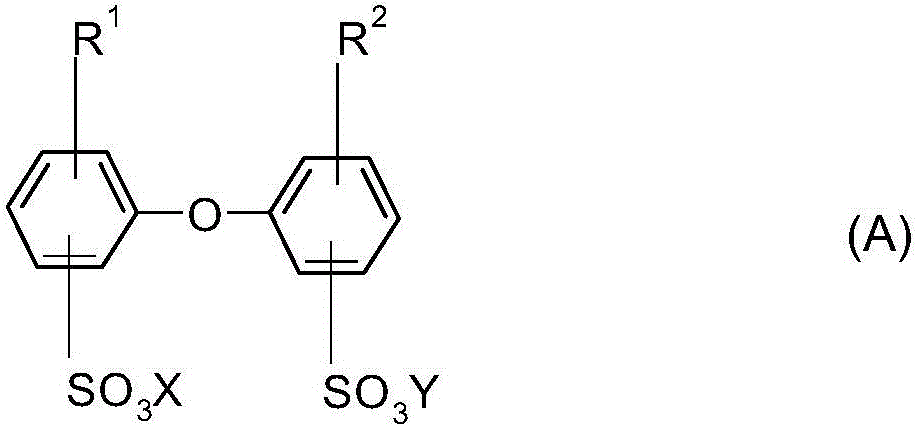Aqueous polymer-silicon oil hybrid composition
一种组合物、聚合物的技术,应用在油墨、涂层、家里用具等方向,能够解决有效性低、昂贵等问题,达到良好应用性能的效果
- Summary
- Abstract
- Description
- Claims
- Application Information
AI Technical Summary
Problems solved by technology
Method used
Image
Examples
Embodiment approach
[0173] A particularly preferred embodiment of the method of the invention comprises the following steps:
[0174] i. dissolving the non-polymerizable silicone oil in the ethylenically unsaturated monomer M;
[0175] ii. emulsifying the solution of non-polymerizable silicone oil obtained in step i. in water containing at least one surfactant, whereby a conventional oil-in-water emulsion (coarse emulsion) is obtained;
[0176] iii. The droplet size of the conventional oil-in-water emulsion of step ii. is crushed to obtain an oil-in-water aqueous microemulsion having an average droplet size as determined by dynamic light scattering of less than 1000 nm, especially 20-500 nm, especially 50-400 nm , that is, aqueous O / W emulsion;
[0177] iv. Initiating free radical polymerization in the aqueous oil-in-water microemulsion of step iii.
[0178] Steps i. and ii. can be carried out as consecutive steps or as a single step. That is, the non-polymerizable silicone oil and the ethylen...
Embodiment 1
[0258] 81.6g Silicone Oil 2 (100% active polysiloxane) was dissolved in 68.4g MMA, 6.08g SMA, 1.52g MAA and 0.23g BDDA. The oil phase was added dropwise to a stirred solution of 20.1 g of Surfactant 1 in 202 g of deionized water. The mixture was stirred for 30 minutes and treated by ultrasound at 60% power for 20 minutes per 500 g of emulsion using a Bandelin Sonoplus, Generator GM 2200, 200 W, 20 kHz. A kinetically stable microemulsion was obtained with an average droplet size of 147 nm.
[0259] 3.8 g of a 10% by weight aqueous solution of tert-butyl hydroperoxide were added to the microemulsion. The microemulsion was heated to 40°C. 15.8 g of a 4.8% by weight Rongalit C aqueous solution were added to the reactor within 1 hour at 40°C. The reaction mixture was continuously stirred by a mechanical stirrer and maintained at 60°C for 1 hour, then cooled to 22°C. The pH of the resulting polymer dispersion was then adjusted to 8.6 by adding 0.87 g of AMP and the dispersion wa...
Embodiment 2
[0261] 81.6g Silicone Oil 3 (100% active polysiloxane) was dissolved in 68.4g MMA, 6.08g SMA, 1.52g MAA and 0.23g BDDA. The oil phase was added dropwise to a stirred solution of 20.1 g of Surfactant 1 in 202 g of deionized water. The mixture was stirred for 30 minutes and treated by ultrasound at 60% power for 20 minutes per 500 g of emulsion using a Bandelin Sonoplus, Generator GM 2200, 200 W, 20 kHz. A kinetically stable microemulsion was obtained with an average droplet size of 154 nm.
[0262] 3.8 g of a 10% by weight aqueous solution of tert-butyl hydroperoxide were added to the microemulsion. The microemulsion was heated to 40°C. 15.8 g of a 4.8% by weight Rongalit C aqueous solution were added to the reactor within 1 hour at 40°C. The reaction mixture was continuously stirred by a mechanical stirrer and maintained at 60°C for 1 hour, then cooled to 22°C. The pH of the resulting polymer dispersion was then adjusted to 8.7 by adding 0.48 g of AMP and the dispersion wa...
PUM
| Property | Measurement | Unit |
|---|---|---|
| glass transition temperature | aaaaa | aaaaa |
| particle diameter | aaaaa | aaaaa |
| glass transition temperature | aaaaa | aaaaa |
Abstract
Description
Claims
Application Information
 Login to View More
Login to View More - R&D
- Intellectual Property
- Life Sciences
- Materials
- Tech Scout
- Unparalleled Data Quality
- Higher Quality Content
- 60% Fewer Hallucinations
Browse by: Latest US Patents, China's latest patents, Technical Efficacy Thesaurus, Application Domain, Technology Topic, Popular Technical Reports.
© 2025 PatSnap. All rights reserved.Legal|Privacy policy|Modern Slavery Act Transparency Statement|Sitemap|About US| Contact US: help@patsnap.com



